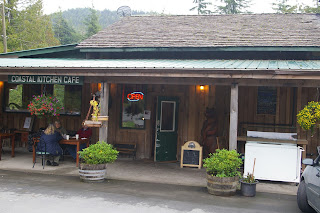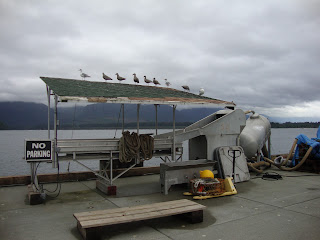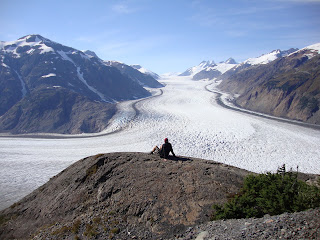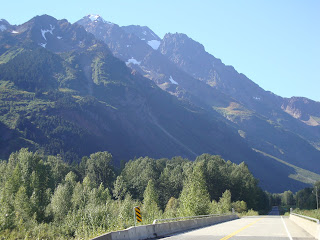Today we decided that since we hadn't had enough of travelling and ferries that we would do a day trip to Port Renfew on the West side of Vancouver Island. There is an old logging road that leads from Honeymoon Bay on Lake Cowichan and winds over the mountains to the tiny town of Port Renfew which is a fishing spot and also being the end of the line from Victoria has a collection of old salties and drifters that couldn't make the trip back to the city and stayed.
 The trip there is through partially logged country with a stop here and there to see a remnant of what was a very beautiful coastal rainforest.
The trip there is through partially logged country with a stop here and there to see a remnant of what was a very beautiful coastal rainforest. We stopped at The Harris Creek big Spruce which is situated on the banks of a fast flowing stream in a very wet and mossy rainforest filled with ferns and wild berries. Then past Lizard Lake and to Port Renfew. We have never seen this town in sunlight since we generally only visit in Winter when the big Pacific storms blast the West Coast. We've come through mists, torrential rains and blinding blizzards to get here in the past and today was mild in comparison with those trips.
We stopped at The Harris Creek big Spruce which is situated on the banks of a fast flowing stream in a very wet and mossy rainforest filled with ferns and wild berries. Then past Lizard Lake and to Port Renfew. We have never seen this town in sunlight since we generally only visit in Winter when the big Pacific storms blast the West Coast. We've come through mists, torrential rains and blinding blizzards to get here in the past and today was mild in comparison with those trips.For the first time ever we've come when the only hotel in town was open but even though the decor was very classy and West coast like with deep green walls and cool pictures and a nice water view the vegetarian fare was almost nonexistent so we decided to go back up the road to the Coastal Kitchen Cafe which was more cool and funky and had a very accomodating staff with a flexible menu. Greg made the observation that when you go to a small town always check out to see where the locals go and that's most likely the spot to be ......so we had found the spot in town. We had a nice pizza and Mum had fish and chips. A few groups of off road bikers came in too. The staff had just come back that morning from a staff trip to Saltspring so we had to tell them we lived there too. They were raving about SSI but did note that it was very expensive there......we just smiled sagely feeling lucky to live where we do.
We took a walk out on the boardwalk and saw the seagulls riding back and forth on the waves as they washed up and down the rocky shore. There are some cabins that are built right on the rocky cliff face so maybe we take a weekend getaway in the Winter and walk in the lashing rains and roaring winds.
We then drove over the wet and misty road back to Lake Cowichan with Mum freaking out that we were all going to die if the road were to give way into the gorge below. Frankly I was thinking that if she carried on distracting me I would certainly fulfil that prophecy and drive willingly into oblivion.
We stopped at the Brass Bell in Crofton while we waited for the ferry and the owner told us that a massive storm with winds of plus 100km an hour and lots of rain had hit the North Vancouver Island and cut off Port Hardy from power and road. My feelings after having been to Port Hardy that they could do with a lot more rain to clean that place up a bit. I also thought how lucky we were since today was supposed to be the day we came back on the ferry from Prince Rupert and I don't think it would have been running given the storm and being trapped in a storm ravaged disaster zone isn't quite what I needed right now.
It's Mum's last week here so we have to get ourselves together and get music copied, photos printed, final shopping done and a short trip to Vancouver in to visit with friends as well.
Here comes the Autumn and the wet and fog ........a time that I like since it's time to settle down and introvert, wrap up and walk in the rain.




















































